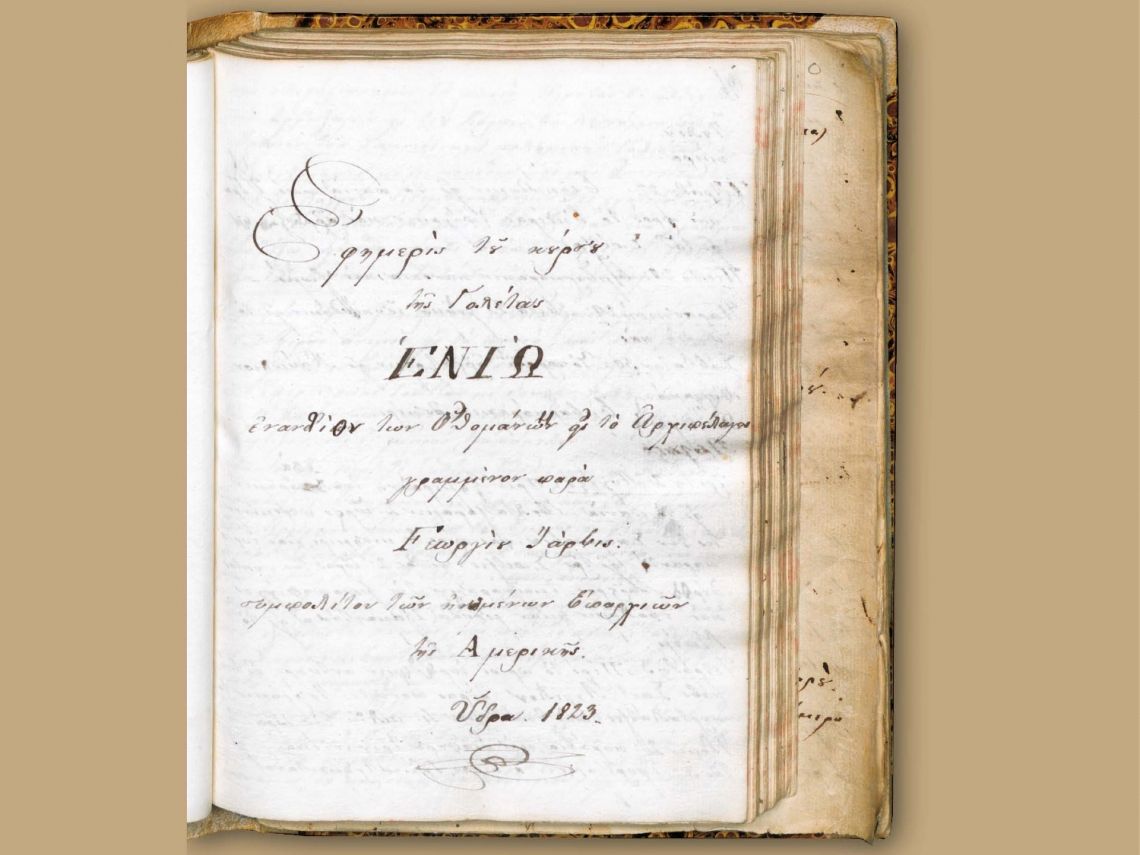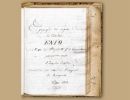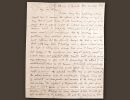The first American volunteer to join the Greek War of Independence in 1822 was George Jarvis, the son of a merchant from New York. Jarvis joined the Greek guerilla fighters (klefts) and became lieutenant-general in the Greek forces, known as “Kapetan Zervis” since he had “become a complete Greek in dress, manners, and language.” Along with Samuel Gridley Howe and Jonathan Peckham Miller he supervised the distribution of humanitarian help to the Greek population. He died of natural causes in Argos on August 11th, 1828.
The most well-known of American Philhellenes was Samuel Gridley Howe from Boston. Howe joined the Greek forces in 1824. From 1826 he served as Chief surgeon on the Greek navy, on the flagship Karteria. Howe’s lively letters from Greece were published in the American newspapers and resulted in raising funds for humanitarian aid. Howe was a true visionary. Not only was he instrumental in distributing supplies and provisions to the Greek population, but he also provided employment to Greek refugees first in building the port on the island of Aegina and then by establishing a model colony for Greek refugees near the Isthmus of Corinth near the town of Examilia.
His colony provided for two hundred families of refugees and it was named Washingtonia. After his return to Boston he became director of the Perkins School for the Blind but he never forgot Greece. When the Cretan revolt of 1866 broke out, he returned to Greece with his wife and two daughters to offer help to the Cretan refugees.
-
Volunteers edited
Journal of the Raid of the Goëlette Enio against the Ottomans in the Archipelago, Written [in Greek] by George Jarvis, Citizen of the United States of America. Hydra, 1823.
Journal of George Jarvis. Vol. 2, p. 95. Finlay Papers. British School at Athens.
-
Volunteers2 edited
In his journal Jarvis recounts how he introduced himself to Prince Ypsilanti. He compares him with Petros "Petrobey" Mavromichalis and Kolokotronis.
The next day (August 1st) he details the preparations for the battle of Myloi. July 30 and August 1, 1822.
Journal of George Jarvis. Vol. 1, pp. 150-151. Finlay Papers. British School at Athens
-
Missionaries4
John Elliot, Portrait of Samuel Gridley Howe. National Historical Museum, Athens

-
Missionaries
Samuel Gridley Howe: The Lafayette of the Greek Revolution

-
Missionaries2
To rekindle interest on the Greek cause, Howe wrote a book on the history of the Greek Revolution.
Despite the fact that Howe thought he had harshly judged some of the Greek leadership, the book shaped American understanding of the Greek Revolution for a century.
Samuel Gridley Howe, An historical sketch of the Greek revolution. New York: White, Gallaher & White, 1828.
Gennadius Library, American School of Classical Studies at Athens
-
Missionaries3
Howe’s book on the history of the Greek Revolution got a lot of press coverage and sold well in the US.

-
Missionaries5
In March 1829 Governor Kapodistrias granted Howe a land of 5,000 stremmata at Examilia near the Isthmus of Corinth in order to found a settlement for Greek refugees. No traces of the settlement of Washingtonia have been identified. Letter of Howe to his friend George Finlay from the Isthmus of Corinth. Howe who is about to leave for the U.S. offers Finlay the superintendency and administration of the ‘colony’ (settlement for Greek refugees) in Corinth.
He is optimistic about the future revenues of the estate, November 25, 1829.
Finlay Papers, FIN/GF/E9 (26). British School at Athens
-
Missionaries6
Howe selected 700 refugees to construct the waterfront in the port in Aegina, Greece’s capital at the time. He paid them for months out of his pocket.
Letter of Howe to George Finlay from Aegina with Howe’s suggestions for improving the port of the island. January 5, 1829. Finlay Papers, FIN/GF/E9 (18). British School at Athens
-
Missionaries7
Karl Krazeisen, Aegina (1826). Engraving.
Bildnisse ausgezeichneter Griechen und Philhellenen, nebst einigen Ansichten und Trachten. Nach der Nature gezeichnet und herausegegeben von Karl Krazeisen, Munich, 1831.
Gennadius Library, American School of Classical Studies at Athens
-
Missionaries8
Samuel Gridley Howe, The Cretan refugees and their American helpers. A statement addressed to the contributors for the relief of Cretan refugees. Boston: Lee and Shepard, 1868.
Gennadius Library, American School of Classical Studies at Athens
-
Missionaries9
Samuel Gridley Howe, Έκθεσις της τε αμερικανοελληνικής Επιτροπής και του δόκτορος Σαμουήλ Γ. Χάου περί των ενεργειών αυτών υπέρ των εν Ελλάδι προσφύγων και των εν Κρήτη γυναικοπαίδων μέχρι 1ης Απριλίου 1868. Athens: Lakonia, 1868.
Gennadius Library, American School of Classical Studies at Athens
-
Missionaries11
Letter of Howe to the Boston Greek Relief Committee about the Cretan refugees. June 19, 1867.
Gennadius Library, American School of Classical Studies at Athens. Gift of Curtis Runnels
Journal of the Raid of the Goëlette Enio against the Ottomans in the Archipelago, Written [in Greek] by George Jarvis, Citizen of the United States of America. Hydra, 1823.
Journal of George Jarvis. Vol. 2, p. 95. Finlay Papers. British School at Athens.
In his journal Jarvis recounts how he introduced himself to Prince Ypsilanti. He compares him with Petros "Petrobey" Mavromichalis and Kolokotronis.
The next day (August 1st) he details the preparations for the battle of Myloi. July 30 and August 1, 1822.
Journal of George Jarvis. Vol. 1, pp. 150-151. Finlay Papers. British School at Athens
John Elliot, Portrait of Samuel Gridley Howe. National Historical Museum, Athens
Samuel Gridley Howe: The Lafayette of the Greek Revolution
To rekindle interest on the Greek cause, Howe wrote a book on the history of the Greek Revolution.
Despite the fact that Howe thought he had harshly judged some of the Greek leadership, the book shaped American understanding of the Greek Revolution for a century.
Samuel Gridley Howe, An historical sketch of the Greek revolution. New York: White, Gallaher & White, 1828.
Gennadius Library, American School of Classical Studies at Athens
Howe’s book on the history of the Greek Revolution got a lot of press coverage and sold well in the US.
In March 1829 Governor Kapodistrias granted Howe a land of 5,000 stremmata at Examilia near the Isthmus of Corinth in order to found a settlement for Greek refugees. No traces of the settlement of Washingtonia have been identified. Letter of Howe to his friend George Finlay from the Isthmus of Corinth. Howe who is about to leave for the U.S. offers Finlay the superintendency and administration of the ‘colony’ (settlement for Greek refugees) in Corinth.
He is optimistic about the future revenues of the estate, November 25, 1829.
Finlay Papers, FIN/GF/E9 (26). British School at Athens
Howe selected 700 refugees to construct the waterfront in the port in Aegina, Greece’s capital at the time. He paid them for months out of his pocket.
Letter of Howe to George Finlay from Aegina with Howe’s suggestions for improving the port of the island. January 5, 1829. Finlay Papers, FIN/GF/E9 (18). British School at Athens
Karl Krazeisen, Aegina (1826). Engraving.
Bildnisse ausgezeichneter Griechen und Philhellenen, nebst einigen Ansichten und Trachten. Nach der Nature gezeichnet und herausegegeben von Karl Krazeisen, Munich, 1831.
Gennadius Library, American School of Classical Studies at Athens
Samuel Gridley Howe, The Cretan refugees and their American helpers. A statement addressed to the contributors for the relief of Cretan refugees. Boston: Lee and Shepard, 1868.
Gennadius Library, American School of Classical Studies at Athens
Samuel Gridley Howe, Έκθεσις της τε αμερικανοελληνικής Επιτροπής και του δόκτορος Σαμουήλ Γ. Χάου περί των ενεργειών αυτών υπέρ των εν Ελλάδι προσφύγων και των εν Κρήτη γυναικοπαίδων μέχρι 1ης Απριλίου 1868. Athens: Lakonia, 1868.
Gennadius Library, American School of Classical Studies at Athens
Letter of Howe to the Boston Greek Relief Committee about the Cretan refugees. June 19, 1867.
Gennadius Library, American School of Classical Studies at Athens. Gift of Curtis Runnels














